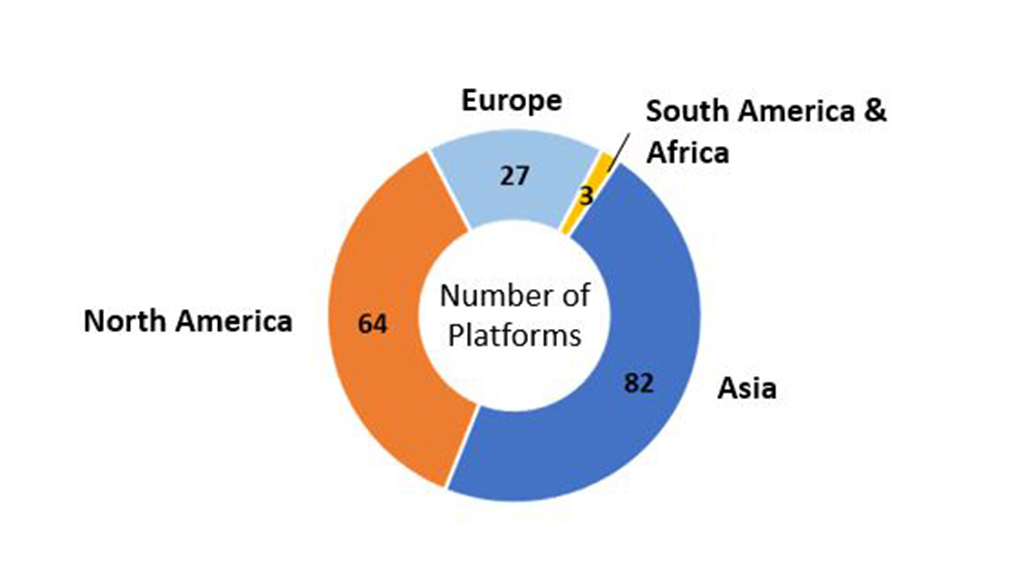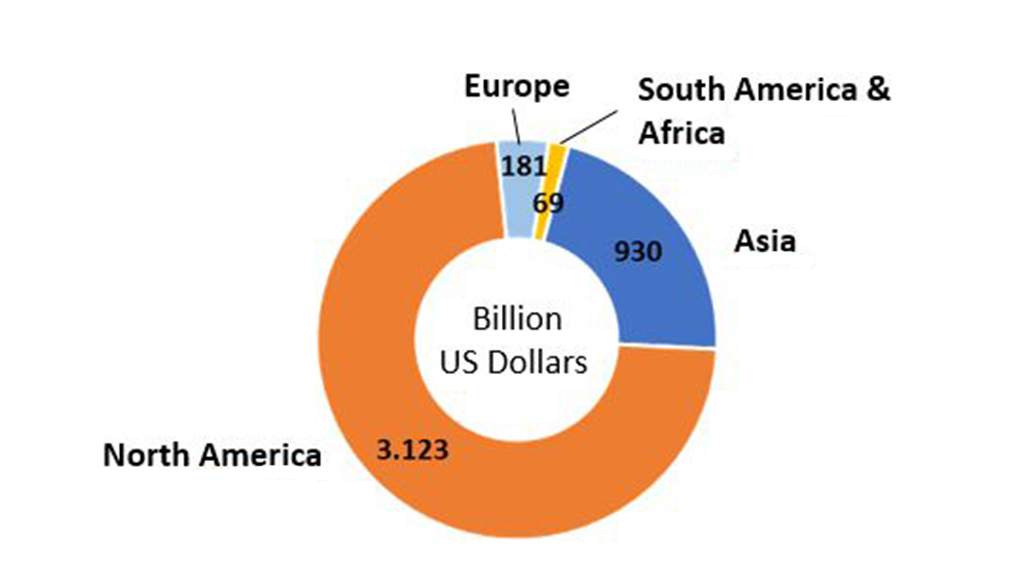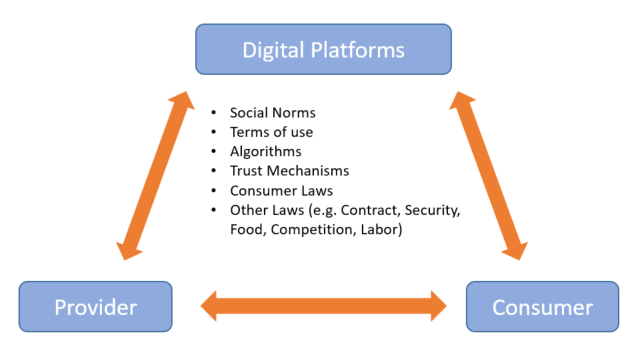
Recently, the German Federal Ministry for Economic Affairs and Energy presented the “White Paper on Digital Platforms” (Federal Ministry for Economic Affairs and Energy, 2017) at the CeBIT trade fair, sketching out a new policy for the internet age. While the players were able to act relatively freely on the markets in the last few years, a comprehensive set of rules is being designed here. It becomes clear that it is a work penned by the ministry of economics: It develops general ideas of how to maintain the achievements of social market economy and at the same time strives for protection of specific German economic interests, in particular in the area of industry 4.0.
Digital Platforms
Digitalization supports scenarios in the area of digital platforms that lead to monopolization and centralization. The background for this are, from an economic point of view, the marginal costs for digital projects, which tend towards zero, in combination with high fixed costs. This leads to rising economies of scale. The “Big Five” of the internet (Apple, Microsoft, Google, Amazon and Facebook) have developed from product-oriented companies into digital platforms in the last few years (Feng & Furr, 2016), which are clear market leaders in their respective competence areas. The platform function as such is also mostly digital and therefore subject to the same laws of scalability. The resulting natural monopolies are reinforced additionally by network effects and standards.
The business model of a platform is in connecting two or several groups of users and permitting direct transactions or other forms of interaction between them. This market function as such is not new, but takes place in shopping centers or classified ads sections in traditional newspapers as well. The innovation was that information technology has reduced the necessity of own physical resources for market place operators.
In addition to platforms that are based on a dedicated strong product range (e.g. for end devices from Apple) or service portfolios (e.g. logistics services at Amazon), there are also companies that perform a purely digital platform function. eBay, Uber or AirBnB are some examples of such pure platform companies. Credit marketplaces fall into this category as well.
In contrast to the conventional production, where control and optimal allocation of resources is an essential factor for success, digital platforms focus on promotion of the entire ecosystem and use of the positive network effect (Van Alstyne et al., 2016).
In addition to combination of supply and demand in the narrower sense, the platforms offer many additional services in areas like payment processing or mechanisms for reputation management; these are of particular interest for smaller companies.
Even though developing into a digital platform is attractive for companies, this step is only realistic for a small number of companies. For the others, the question arises of how to best use and integrate the existing platforms in their business models.
The Home of Digital Platforms
A study on digital platforms around the world (Evans & Gawer 2016) shows that the corporate headquarters of the largest players by market capitalization are very unevenly spread geographically: 47 % are located in Asia, 36 % in North America, but only 15 % in Europe (3 % of the global total are based in Germany). South America and Africa play virtually no role at all.

How can this distribution be explained? All but one of the platforms in North America are located in the USA. More than two thirds of those companies in turn reside in Silicon Valley. A cost-efficient innovation environment, as well as liberal legal framework conditions are ideal starting conditions. Many companies were able to secure good market positions early on this way.
Most of the Asian platforms are located in China. At 64 platforms, the number founded in China alone equals that of North America. Separation, protectionism and targeted state support have prompted the development of pendants to the US-platforms (e.g. Alibaba, Baidu, AliPay, XiaMi). In Europe, the 27 listed digital platforms are spread out among 10 countries: Great Britain (9 platforms) and Germany (5 platforms) are the largest players.
A look at market capitalization shows a shift to the benefit of North American platforms.

These differences due to different investment cultures play an important role in development of the market in that the funds for acquisitions are filled well by high market capitalization. This also clearly increases the opportunities of prevailing in cut-throat competition.
Platforms Need Rules
The market-dominating positions of digital platforms are social challenges between the poles of free market economy and regulation. The regulation demand on platforms is multi-layered. The inherently border-crossing character of many digital offers also makes regulation difficult.

- Social standards: Statements that are subject to free speech in some countries are crimes in Germany. “Hate speech” is one example of this. Social standards and the framework of rules and values of a society should be reflected in the digital platforms as well.
- Terms of use: Digital platforms typically have innumerable pages of hard to understand general terms and conditions today that are too much for average users to handle. A short, well-structured and transparent presentation of what happens with collected data and how the business model of the platform works would be desirable here (the so-called “One-Pager”).
- Algorithms: Google not only controls the market for online ads, but determines placement of online ads as well as the generic search results of corporate websites through their implemented algorithms. This gives it essential influence on the economic success of other companies via the algorithms used as well. The algorithms, protected as trade secrets, are therefore of public interest as well in order to ensure fair competition.
- Trust mechanisms: Evaluation systems integrated into digital platforms make it possible to reduce insecurities regarding the expected quality, e.g. for smaller restaurants or hotels, though this is otherwise only possible for strong brands with branches (Brynjolfsson & McAfee, 2014, chap. 8). This trust mechanism transfers the strong and trustworthy brand of the platform operator to an unknown individual provider. Again, the algorithms implemented and the mechanisms to secure integrity decisively influence entrepreneurial success of market participants.
- Consumer protection: The importance of consumer protection and data privacy in Germany is different from that, e.g., in the USA. For example, a mobile phone provider’s services such as speech services or text messages on the smartphone are currently subject to the German data privacy regulations. Facebook with its WhatsApp service has a comparable offer, but does not need to adhere to the same rules.
The state is the system of public institutions for controlling public matters. Platform companies have gained a dominant role in many business, media and social public areas in the last few years and avoided state regulation in large areas. In this respect, the question of regulation of the activities on the digital platforms as well as the general competitive framework is more than justified. The latter is, e.g., about limiting market power by modern merger control or the subject of fair taxes.
A Third Path for Europe?
In the USA, technology is allowed to develop mostly independently of state regulation. This will become even more the case under the new US government, which has announced to deconstruct the administrative state. In China, in contrast, the market entry of international players is systematically prevented. Own companies are able to develop only subject to the narrow regulations set by the state. Neither approach can be used as a role model for Germany and Europe due to the different cultural and social situations. Social market economy should be reflected in the platform economy as well.
The submitted white paper is worth reading. It is a good and important basis for necessary regulations and a third path between the mostly unregulated digital environment in the USA and the state-dominated and organized modernization program in China. Is this attempt at regulation too late, as some believe? Maybe, a little. On the other hand, acting early on a developing market inhibits innovation and may leave essential experience of technology use unconsidered. By explicit consideration of innovation-promoting experimenting clauses, the white paper takes new paths of reconciliation of regulation needs and innovation capacity. Now, the results of the discussion must be quickly implemented in specific measures.
This article contains excerpts from Baldi, S. (2016), Grenzenlos digital und digitale Grenzen, in: Digital vernetzt, Jung H.H. and Kraft, P. (Eds.), Hanser Verlag, and is published with kind consent of Hanser Verlag.
Sources:
- Van Alstyne, M. W., Parker, G. G., & Choudary, S. P. (2016). Pipelines, Platforms, and the New Rules of Strategy. Harvard Business Review, 94(4), 54–62.
- Bundesministerium für Wirtschaft und Energie. (2017). Weißbuch digitale Plattformen: Digitale Ordnungspolitik für Wachstum, Innovation, Wettbewerb und Teilhabe.
- Brynjolfsson, E., & McAfee, A. (2014). The Second Machine Age: Work, Progress, and Prosperity in a Time of Brilliant Technologies (Kindle Ed.). New York, London.
- Evans, P. C., & Gawer, A. (2016). The Rise of the Platform Enterprise: A Global Survey.
- Feng, Z., & Furr, N. (2016). Products to Platforms : Making the Leap. Harvard Business Review, 94(4), 72–78.
- OECD (2016). Protecting Consumers in Peer Platform Markets: Exploring the Issues.




